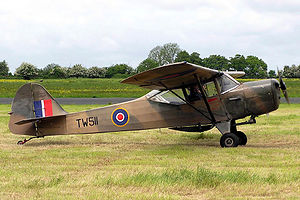Taylorcraft Auster V
| Auster | |
|---|---|
 |
|
| Privately owned Auster AOP.V restored to its RAF colours | |
| Role | Liaison aircraft |
| Manufacturer | Taylorcraft Aeroplanes (England) Limited |
| Introduction | 1942 |
| Primary user | Royal Air Force |
| Number built | 1,630 |
| Developed from | Taylor Cub |
| Variants | Beagle A.61 Terrier |
The Taylorcraft Auster was a British military liaison and observation aircraft produced by the Taylorcraft Aeroplanes (England) Limited company during the Second World War.
The Auster was a twice-removed development of an American Taylorcraft design of civilian aircraft, the Model A. The Model A had to be redesigned in Britain to meet more stringent Civil Aviation standards and was named the Taylorcraft Plus C. After the start of the Second World War, the company developed the model further as an Air Observation Post (AOP)—flown by officers of the Royal Artillery and used for directing artillery fire of British Army Royal Artillery units.
The Plus C was re-engined with the Blackburn Cirrus Minor I engine and redesignated the Taylorcraft Plus D. Most of the civil Plus Cs and Ds were impressed into Royal Air Force service, the Plus Cs were re-engined with the Cirrus Minor I and redesignated as Plus C2.
Prewar tests identified the Taylorcraft Model D as the most suitable aircraft for the AOP role. Three more Ds were purchased from Taylorcraft and a trials unit, D Flight, under Major Charles Bazeley RA, formed at Old Sarum on 1 February 1940. The flight with three Austers and one Stinson Voyager, and three artillery and one RAF pilots, moved to France where they trained with artillery and practised fighter avoidance with Hurricanes of Air Component before moving south to train with French artillery. The flight did not participate in the fighting and withdrew without loss to the UK. However, the War Office then ordered 100 Stinson L-1 Vigilants. Formation of the RAF's Army Cooperation Command in December 1940 led to the RAF rejecting the very notion of light AOP aircraft.
Intercession by General Alan Brooke led to an accommodation that led to the first AOP pilot course for artillery officers taking place in October 1940 and in 1941, the first AOP squadron, No 651, formed. Stinson Vigilants eventually arrived in early 1942 but most had been severely damaged in transit leading to the adoption of the Taylorcraft Auster 1 and an order for 100 aircraft placed. Some of the Stinsons were resurrected but found to be too big for the AOP role.
...
Wikipedia
